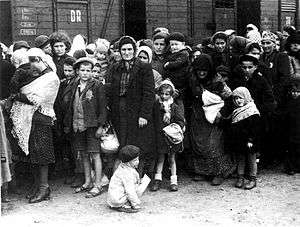Tykocin pogrom
| Part of a series on | ||||||||||
| The Holocaust | ||||||||||
|---|---|---|---|---|---|---|---|---|---|---|
 | ||||||||||
|
||||||||||
|
Atrocities |
||||||||||
|
Camps
|
||||||||||
|
Lists Deportations of French Jews
to death camps |
||||||||||
|
Remembrance |
||||||||||
The Tykocin massacre (pogrom),[1] of August 25, 1941, was the mass murder of Jewish residents of Tykocin in occupied Poland during World War II, soon after Nazi German attack on the Soviet Union.
Circumstances surrounding the massacre
The town of Tykocin was conquered by Nazi Germany during the Soviet and German invasion of Poland pursuant to their secret agreement known as the Molotov–Ribbentrop Pact. At the end of September 1939, the area was transferred by the Nazis to the Soviet Union in accordance with the German–Soviet Boundary Treaty.[2]

In their attack, the Red Army overrun 52.1% of territory of interwar Poland with over 13,700,000 inhabitants. The Soviet occupation zone included also 336,000 new refugees who escaped from Polish lands invaded by Germany, most of them Polish Jews numbering at around 198,000.[3] Spreading terror throughout the region, the Soviet secret police (NKVD) accompanying the Red Army massacred Polish prisoners of war,[4][5][6] and in less than two years, deported up to 1.5 million ethnic Poles to Siberia.[7] Twenty-one months after the Soviet invasion of Poland, during the German Operation Barbarossa in June 1941, the town was overrun again, this time by Wehrmacht followed closely behind by Einsatzgruppen. The Germans installed Jan Fibich, a local ethnic German, as mayor. Fibich, aided by Edmund Wiśniewski, prepared a list of Jews collaborating with the Soviet NKVD, which included almost all of Jewish youth.[2]
The executions
Upon their arrival, the Nazi Germans encouraged the local Poles from Tykocin and the surrounding villages to loot Jewish property, which they later ordered to be given back to their proper owners, for the Germans' own anticipated benefit.[8][9][10] On the morning of August 25, 1941 – according to a testimony of Abraham Kapice – as explained also by the Jewish and Polish memorials on the outskirts of town,[11] the Germans ordered all Tykocin Jews to gather at the market square in order to be "resettled" to a ghetto in Czerwony Bór. About 1,400–1,700 people were soon taken from the square to a killing site in the nearby Łopuchowo forest. The men were marched on foot, and the women with children were trucked in.[12] Some local Jews managed to escape into hiding, though very few survived.[13] The prisoners, including women, children, and the elderly, were executed in waves into the execution pits, by an SS Einsatzkommando firing squad under the command of SS-Obersturmführer Hermann Schaper.[11][14][15] Shaper's mass executions of Polish Jews spread across many villages and towns of the Białystok region around the same time, including Radziłów, Jedwabne, Łomża, Rutki, Wizna, Piątnica, and Zambrów. He was brought to justice several decades later by the German authorities, but managed to deceive the interrogators during his original trial in Ludwigsburg.[16]
See also
References
- ↑ Israel's Picture Library LTD 1991-2009
- 1 2 Menachem Turek, "Życie i zagłada Żydów w Tykocinie podczas niemieckiej okupacji" Archiwum Żydowskiego Instytutu Historycznego. Translated by Sylwia Szymańska
- ↑ Elżbieta Trela-Mazur (1997). Włodzimierz Bonusiak; Stanisław Jan Ciesielski; Zygmunt Mańkowski; Mikołaj Iwanow, eds. Sowietyzacja oświaty w Małopolsce Wschodniej pod radziecką okupacją 1939-1941 (Sovietization of education in eastern Lesser Poland during the Soviet occupation 1939-1941) (in Polish). Kielce: Wyższa Szkoła Pedagogiczna im. Jana Kochanowskiego. p. 294. ISBN 83-7133-100-2., also in Wrocławskie Studia Wschodnie, Wrocław, 1997
- ↑ Contested memories By Joshua D. Zimmerman, Rutgers University Press - Publisher; page 67-68
- ↑ Sanford, p. 23; (Polish) Olszyna-Wilczyński Józef Konstanty, Encyklopedia PWN. Retrieved 14 November 2006.
- ↑ (Polish) Śledztwo w sprawie zabójstwa w dniu 22 września 1939 r. w okolicach miejscowości Sopoćkinie generała brygady Wojska Polskiego Józefa Olszyny-Wilczyńskiego i jego adiutanta kapitana Mieczysława Strzemskiego przez żołnierzy b. Związku Radzieckiego. (S 6/02/Zk) at the Wayback Machine (archived January 7, 2005) Polish Institute of National Remembrance. Internet Archive, 16.10.03. Retrieved 16 July 2007.
- ↑ Jerzy Jan Lerski, Piotr Wróbel, Richard J. Kozicki, Historical Dictionary of Poland, 966-1945, Greenwood Publishing Group, 1996, ISBN 0-313-26007-9, Google Print, 538
- ↑ Antony Polonsky, Joanna B. Michlic, The Neighbors Respond: The Controversy Over the Jedwabne Massacre in Poland, Princeton University Press, 2004, ISBN 0-691-11306-8, p. 281
- ↑ Andrzej Żbikowski, Nie było rozkazu in "Rzeczpospolita" - January 4, 2001; (Polish)
- ↑ "Tykocin," translated from Yiddish by Stan Goodman, no name of author; original published by Pinkas haKehilot branch of Yad Vashem
- 1 2 Linda and Andy Berger, Evelyn and Marc Fisher, Marcy and Mark Kanter, UJC Cincinnati mission to Poland and Israel
- ↑ (Polish) Gmina Tykocin. Temat: Tykocin, Lopuchowo, at mieszas.republika.pl; also at Tykocin na mapie polskich judaików, at www.kirkuty.xip.pl
- ↑ Shmuel Spector, Geoffrey Wigoder, The Encyclopedia of Jewish Life Before and During the Holocaust, NYU Press, 2001, ISBN 0-8147-9356-8, pp. 1352-1353
- ↑ Alexander B. Rossino, "Contextualizing Anti-Jewish Violence in the Białystok District during the Opening Weeks of Operation Barbarossa," Polin: Studies in Polish Jewry, Volume 16 (2003)
- ↑ Jackie Feldman, Above the Death Pits, Beneath the Flag Published by Berghahn Books, New York, Oxford, 2008, 307 pages.
- ↑ (Polish) Thomas Urban, reporter of the Suddeutsche Zeitung; text in Polish: "Poszukiwany Hermann Schaper" at the Wayback Machine (archived November 24, 2007), Rzeczpospolita, 1–2 September 2001, Nr 204; retrieved from the Internet Archive.
Coordinates: 53°12′11″N 22°46′15″E / 53.20306°N 22.77083°E